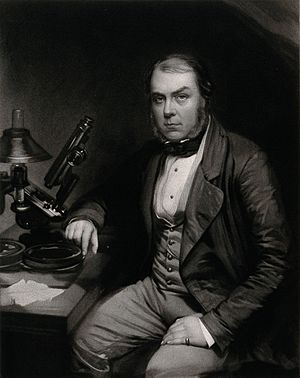John Thomas Quekett facts for kids
John Thomas Quekett (born August 11, 1815 – died August 20, 1861) was an English scientist. He was an expert in microscopes and histology. Histology is the study of tiny tissues in living things.
Quekett studied medicine at the London Hospital in 1831. He became a qualified apothecary and a member of the Royal College of Surgeons of England.
In 1839, he helped start the Royal Microscopical Society with his brother, Edwin John Quekett. Quekett was the society's secretary for many years. Later, he became a conservator (someone who looks after collections) at the Hunterian Museum. He also became a professor of histology there.
Early Life and Education
John Quekett was born in Langport, England, on August 11, 1815. He was the youngest son of William Quekett. His father was a schoolmaster and taught his sons at home. Each son was encouraged to collect items for natural history.
When John was only sixteen, he gave talks about microscopic subjects. He used his own drawings and a microscope he built himself. He made it from a roasting-jack, a parasol, and some brass pieces.
After school, he trained to be a surgeon. He studied at King's College, London and the London Hospital medical school. In 1840, he became qualified. He also won a special award for studying human and animal anatomy.
Career and Discoveries
Quekett created a huge and valuable collection of microscopic samples. These samples showed plant and animal tissues, both healthy and diseased. They proved how useful microscopes were for scientific study.
In November 1843, he became an assistant conservator at the Hunterian Museum. This museum is part of the Royal College of Surgeons. In 1844, he became a demonstrator of tiny anatomy.
In 1846, the college bought his collection of 2,500 samples. They asked him to write a detailed book about all the tissue samples in the museum. In 1852, his job title changed to professor of histology. He later became the main conservator of the museum in 1856.
Sadly, his health got worse, and he died on August 20, 1861.
Contributions to Science
Quekett was very active in the scientific community. In 1841, he became the secretary of the Microscopical Society. He held this role until 1860. He was then elected president but was too ill to attend meetings.
He became a member of the Linnean Society in 1857. In 1860, he was elected a Fellow of the Royal Society. This is a very high honor for scientists.
Quekett's work on histology was very original. It greatly influenced how doctors studied anatomy in England. His book, Practical Treatise on the Use of the Microscope (first published in 1848), helped many doctors and hobbyists learn about microscopes. Even Prince Albert came to him for lessons!
To honor his work, the Quekett Microscopical Club was started in 1865.
Key Publications
Quekett wrote several important books and papers:
- Practical Treatise on the Use of the Microscope, 1848. This book was very popular and was even translated into German.
- Descriptive and Illustrated Catalogue of the Histological Series … in the Museum of the Royal College of Surgeons, 1850 and 1855. This was a detailed catalog of the museum's tissue collections.
- Lectures on Histology, 1852 and 1854. These books shared his knowledge about the study of tissues.
- He also wrote papers for the Microscopical Society's Transactions. One important paper was about the structure of bones in different animals.


